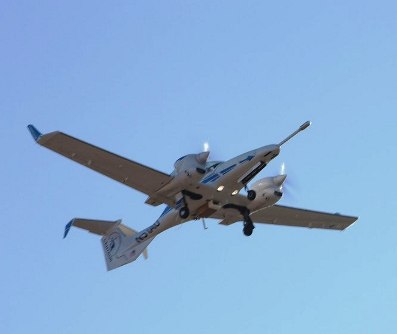NOAA’s Best Aircraft Turbulence Probe is Prepared to Measure
February, 2013
Scientists from ARL’s Atmospheric Turbulence and Diffusion Division (ATDD) participated in the first successful test flight of the Fluxes of Carbon from an Airborne Laboratory (FOCAL) system on board the Centaur aircraft. The Centaur is owned by Aurora Flight Sciences Corporation. FOCAL is a new airborne instrument system, designed by ATDD and Harvard University’s Anderson Group, for measuring fluxes of carbon dioxide and methane, two important greenhouse gases. Test flights are being made to prepare for a research study the scientists will begin in August in the permafrost region of Alaska. ATTD’s Best Aircraft Turbulence (BAT) probe is a key part of the FOCAL system. The probe is a custom-designed wind sensor that can be mounted to the front of an aircraft (see picture on right) to make high frequency measurements of atmospheric pressure, air temperature, and turbulence—chaotic, three dimensional flow of winds that drive upward and downward transport of mass, momentum, and energy between the surface of the Earth and the lower part of the atmosphere.

Centaur aircraft carrying BAT probe and other instruments during the test flight. Photo Credit: NOAA
The Centaur aircraft flew out of Goldsboro, NC this month with the system on board to obtain Federal Aviation Administration certification and to verify that the instruments (particularly the BAT probe) did not adversely affect the handling and performance of the aircraft. This first test flight represents a major milestone in the development and integration of the FOCAL system.
Background: ATDD has been working with Harvard University’s Anderson Group since 2010 to develop a system that could measure fluxes of methane gas from an aircraft. The system combines the BAT probe with a powerful, new, high-rate trace-gas analyzer from Harvard’s Anderson Group; installed on a light twin-engine DA-42 airplane operated by Aurora Flight Sciences Corporation. In June 2012, ATDD, Harvard University, and Aurora Flight Sciences were awarded an NSF grant for research to be conducted in the permafrost region of Alaska. Test flights were scheduled to prepare the aircraft and the instruments for the Alaska study.
Significance: In recent decades, high-latitude areas of the Earth have been observed to be warming more quickly than the rest of the planet. This warming has led to thawing of permafrost regions. As the ice melts, stored carbon gases (methane and carbon dioxide) are released into the air. Methane and carbon dioxide are two of the most important greenhouse gases contributing to the warming of the planet. A potential exists for positive feedback whereby increased warming of the planet increases the thawing of the ice releasing more greenhouse gases and further increasing the warming. It is very important to understand how much and how widespread these gases are being released over high latitude areas and from which land surfaces. It is also vital to assess the feedback potential (if any) to know how carbon emissions are changing over time with changes in temperature.
At this time, collecting airborne measurements with a system like this is the most practical and immediate way to get widely distributed observations. Climate models require observations in order to evaluate the performance of the models. In the future, satellite monitoring may become possible, but its development will require the models to relate emissions to quantities observable from orbit.

